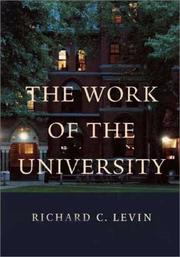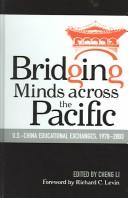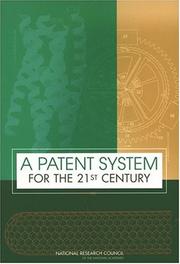| Listing 1 - 7 of 7 |
Sort by
|

ISBN: 1281735094 9786611735098 0300135351 9780300135350 9780300100013 0300100019 9781281735096 6611735097 Year: 2003 Publisher: New Haven
Abstract | Keywords | Export | Availability | Bookmark
 Loading...
Loading...Choose an application
- Reference Manager
- EndNote
- RefWorks (Direct export to RefWorks)
This engaging collection of speeches and essays, published on the occasion of Richard C. Levin's tenth anniversary as president of Yale University, reflects both the range of his intellectual passions and the depth of his insight into the work of the university. By turns analytical, reflective, and exhortatory, Levin explores what it means to be a world-class university, how the university intersects with local and global communities, and why a liberal education matters. He offers personal recollections of schools, teachers, and traditions of particular importance in his own life. And, returning to his roots as a professor of economics, he discusses the competitiveness of American industry and the relations between the market economy and American democracy.Throughout these writings Levin illuminates and inspires. Always his affection for the university shines through. Whether greeting incoming freshmen, meditating on September 11, remembering an intellectual hero, saluting graduating seniors, addressing the League of Women Voters, or celebrating Yale's Tercentennial, Levin, by example, shows what a liberal education can achieve.
Education, Higher --- Aims and objectives --- Yale University. --- Yale College (1718-1887) --- Universiṭat Yel --- 耶鲁大学 --- Ĭelʹskiĭ universitet --- Йельский университет --- Ĭelʹ (University) --- Йель (University) --- 378.4 <73 NEW HAVEN> --- 378.4 <73 NEW HAVEN> Universiteiten--Verenigde Staten van Amerika. VSA. USA--NEW HAVEN --- Universiteiten--Verenigde Staten van Amerika. VSA. USA--NEW HAVEN --- Yale university.
Book
Year: 1989 Publisher: Cambridge, Mass. National Bureau of Economic Research
Abstract | Keywords | Export | Availability | Bookmark
 Loading...
Loading...Choose an application
- Reference Manager
- EndNote
- RefWorks (Direct export to RefWorks)

ISBN: 0739109952 0739109944 Year: 2005 Publisher: Lanham Lexington books
Abstract | Keywords | Export | Availability | Bookmark
 Loading...
Loading...Choose an application
- Reference Manager
- EndNote
- RefWorks (Direct export to RefWorks)
Educational exchanges --- Geschiedenis van opvoeding en onderwijs --- Handboeken en inleidingen. --- United States --- China --- Relations --- S02/0310 --- S09/0610 --- S14/0620 --- S14/0700 --- China: General works--Intercultural dialogue --- China: Foreign relations and world politics--China and USA: since 1949 --- China: Education--Chinese students/scholars abroad: since 1979 --- China: Education--Foreign students/scholars in China
Book
ISBN: 9780300197259 Year: 2013 Publisher: New Haven, CT ; London Yale University Press
Abstract | Keywords | Export | Availability | Bookmark
 Loading...
Loading...Choose an application
- Reference Manager
- EndNote
- RefWorks (Direct export to RefWorks)

ISBN: 0309089107 9786610179831 128017983X 0309567068 9780309567060 9780309089104 9781280179839 6610179832 0309182212 9780309182218 Year: 2004 Publisher: Washington, D.C. National Academies Press
Abstract | Keywords | Export | Availability | Bookmark
 Loading...
Loading...Choose an application
- Reference Manager
- EndNote
- RefWorks (Direct export to RefWorks)
Patents --- Patent practice --- Technological innovations --- Intellectual property --- Patents as Topic --- Technology --- Diffusion of Innovation --- Technology, Industry, and Agriculture --- Intellectual Property --- Communication --- Technology, Industry, Agriculture --- Jurisprudence --- Information Science --- Social Control, Formal --- Sociology --- Health Care Economics and Organizations --- Social Sciences --- Health Care --- Anthropology, Education, Sociology and Social Phenomena --- Technology - General --- Engineering & Applied Sciences --- Evaluation --- Economic policy --- Evaluation. --- Breakthroughs, Technological --- Innovations, Industrial --- Innovations, Technological --- Technical innovations --- Technological breakthroughs --- Technological change --- Patent procedure --- Industrial property --- Intangible property --- Creative ability in technology --- Inventions --- Domestication of technology --- Innovation relay centers --- Research, Industrial --- Technology transfer --- Patent laws and legislation
Book
Year: 1989 Publisher: Cambridge, Mass. National Bureau of Economic Research
Abstract | Keywords | Export | Availability | Bookmark
 Loading...
Loading...Choose an application
- Reference Manager
- EndNote
- RefWorks (Direct export to RefWorks)
This paper analyzes R&D policies when the returns to cost-reducing and demand-creating R&D are imperfectly appropriable and market structure is endogenous. Previous characterizations of appropriability are generalized to permit the possibility that own and rival R&D are imperfect substitutes. We also describe how. equilibrium expenditures on process and product R&D, as well as equilibrium market structure, depend on technological opportunities and spillovers. In contrast to previous work, diminished appropriability does not necessarily reduce R&D expenditures. For example, under some conditions, an increase in the extent of process (product) spillovers will lead to an increase in product (process) R&D. We estimate several variants of the model using manufacturing line of business data and data from a survey of R&D executives.
Book
Year: 1987 Publisher: Cambridge, Mass. National Bureau of Economic Research
Abstract | Keywords | Export | Availability | Bookmark
 Loading...
Loading...Choose an application
- Reference Manager
- EndNote
- RefWorks (Direct export to RefWorks)
Using data from the Federal Trade Commission's Line of Business Program and survey measures of technological opportunity and appropriability conditions, this paper finds that overall firm size has a very small, statistically in- significant effect on business unit R & D intensity when either fixed industry effects or measured industry characteristics are taken into account. Business unit size has no effect on the R & D intensity of business units that perform R & D, but it affects the probability of conducting R & D. Business unit and firm size jointly explain less than one per cent of the variance in R & D intensity; industry effects explain nearly half the variance.
| Listing 1 - 7 of 7 |
Sort by
|

 Search
Search Feedback
Feedback About UniCat
About UniCat  Help
Help News
News